brake light Peugeot Bipper 2008.5 Owner's Manual
[x] Cancel search | Manufacturer: PEUGEOT, Model Year: 2008.5, Model line: Bipper, Model: Peugeot Bipper 2008.5Pages: 140, PDF Size: 1.65 MB
Page 5 of 140

8
Familiarisation INSTRUMENTS AND CONTROLS
1. Steering wheel adjustment control.
2. Lights and direction indicators controls.
3. Instrument panel.
4. Driver's air bag.
Horn.
5. Cruise control/speed limiter switch.
6. Gear lever.
7. Handbrake.
8. Bonnet release.
9. Exterior mirror controls.
10. Fuse box.
11. Manual headlamp height adjustment.
12. Side adjustable and closing vent.
13. Front side window demisting vent.
14. Windscreen demisting vent.
15. Steering lock and ignition.
16. Wipers/wash-wipe/trip computer controls.
17. Central adjustable and closing vents.
18. Passenger air bag.
19. MENU button.
20. Glove box.
21. Lighter.
22. Ashtray.
23. Heating/air conditioning controls.
24. Audio equipment.
25. Electric window controls.
26. 12 V socket.
Page 18 of 140
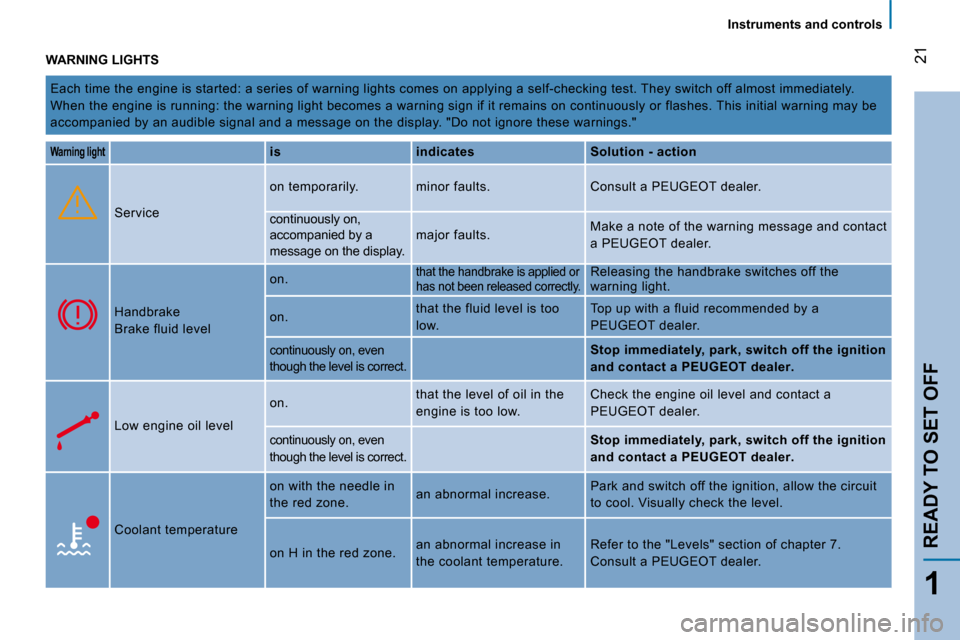
21
1
READY TO SET OFF
Instruments and controls
WARNING LIGHTS
Each time the engine is started: a series of warning lights comes on applying a self-checking test. T hey switch off almost immediately.
When the engine is running: the warning light becom es a warning sign if it remains on continuously or flashes. This initial warning may be
accompanied by an audible signal and a message on t he display. "Do not ignore these warnings."
Warning light
is indicates Solution - action
Service on temporarily. minor faults. Consult a PEUGEOT
dealer.
continuously on,
accompanied by a
message on the display. major faults.
Make a note of the warning message and contact
a PEUGEOT dealer.
Handbrake
Brake fluid level on.
that the handbrake is applied or
has not been released correctly. Releasing the handbrake switches off the
warning light.
on. that the fluid level is too
low. Top up with a fluid recommended by a
PEUGEOT dealer.
continuously on, even
though the level is correct.
Stop immediately, park, switch off the ignition
and contact a
PEUGEOT dealer
.
Low engine oil level on.
that the level of oil in the
engine is too low. Check the engine oil level and contact a
PEUGEOT dealer.
continuously on, even
though the level is correct.
Stop immediately, park, switch off the ignition
and contact a
PEUGEOT dealer
.
Coolant temperature on with the needle in
the red zone.
an abnormal increase. Park and switch off the ignition, allow the circui
t
to cool. Visually check the level.
on H in the red zone. an abnormal increase in
the coolant temperature. Refer to the "Levels" section of chapter 7.
Consult a PEUGEOT dealer.
Page 20 of 140
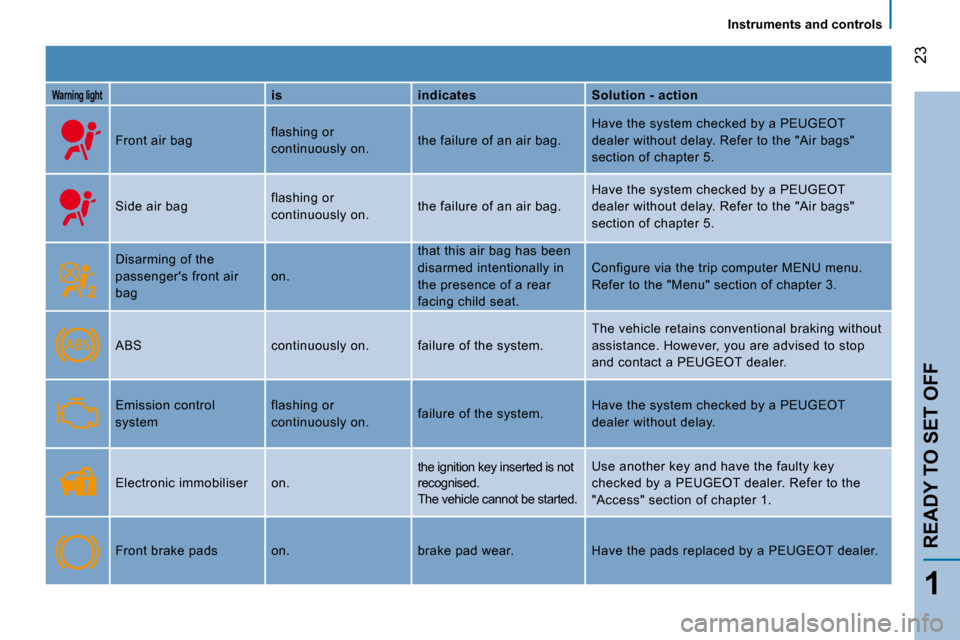
23
1
READY TO SET OFF
Instruments and controls
Warning light
is indicates Solution - action
Front air bag flashing or
continuously on. the failure of an air bag. Have the system checked by a PEUGEOT
dealer without delay. Refer to the "Air bags"
section of chapter 5.
Side air bag flashing or
continuously on. the failure of an air bag. Have the system checked by a PEUGEOT
dealer without delay. Refer to the "Air bags"
section of chapter 5.
Disarming of the
passenger's front air
bag on. that this air bag has been
disarmed intentionally in
the presence of a rear
facing child seat. Configure via the trip computer MENU menu.
Refer to the "Menu" section of chapter 3.
ABS continuously on. failure of the system. The vehicle retains conventional braking without
assistance. However, you are advised to stop
and contact a PEUGEOT dealer.
Emission control
system flashing or
continuously on.
failure of the system. Have the system checked by a PEUGEOT
dealer without delay.
Electronic immobiliser on.
the ignition key inserted is not
recognised.
The vehicle cannot be started. Use another key and have the faulty key
checked by a PEUGEOT dealer. Refer to the
"Access" section of chapter 1.
Front brake pads on. brake pad wear. Have the pa ds replaced by a PEUGEOT dealer.
Page 23 of 140

26
Instruments and controls
Warning light
is indicates Solution - action
Rear parking
assistance on. failure of the system. The audible assistance is no longer active.
Have the system checked by a PEUGEOT
dealer without delay.
Piloted manual gearbox on, accompanied
by the flashing of
"AUTO". failure of the gearbox.
Have the system checked by a PEUGEOT
dealer without delay.
Display displays indicates Solution - action
Exterior temperature the temperature which
flashes accompanied
by a message on the
display. weather conditions
which could result in the
presence of ice on the
road.
Be especially vigilant and do not brake
sharply. Refer to the "Driving safety" section of
chapter 5.
Date
11:00:00 a setting:
of the Date.
of the Time. a configuration via the
MENU menu.
Refer to the "Menu" section of chapter 3.
Headlamp beam height a headlamp height
setting. a position from 0 to 3
depending on the load
carried. Adjust using the control on the fascia panel.
Refer to the "Steering wheel controls" section
of chapter 1.
Page 24 of 140
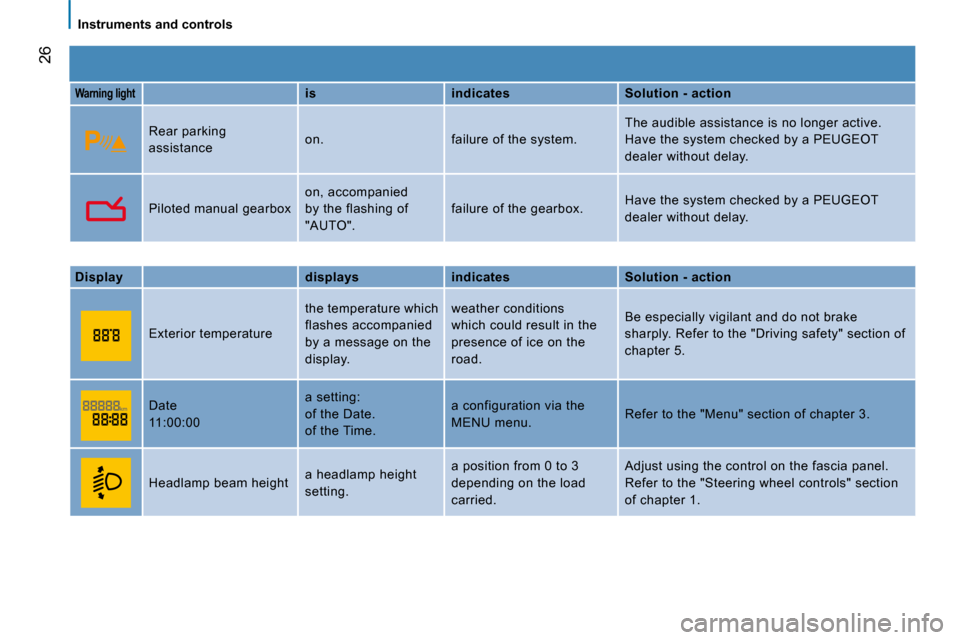
26
Instruments and controls
Warning light
is indicates Solution - action
Rear parking
assistance on. failure of the system. The audible assistance is no longer active.
Have the system checked by a PEUGEOT
dealer without delay.
Piloted manual gearbox on, accompanied
by the flashing of
"AUTO". failure of the gearbox.
Have the system checked by a PEUGEOT
dealer without delay.
Display displays indicates Solution - action
Exterior temperature the temperature which
flashes accompanied
by a message on the
display. weather conditions
which could result in the
presence of ice on the
road.
Be especially vigilant and do not brake
sharply. Refer to the "Driving safety" section of
chapter 5.
Date
11:00:00 a setting:
of the Date.
of the Time. a configuration via the
MENU menu.
Refer to the "Menu" section of chapter 3.
Headlamp beam height a headlamp height
setting. a position from 0 to 3
depending on the load
carried. Adjust using the control on the fascia panel.
Refer to the "Steering wheel controls" section
of chapter 1.
Page 46 of 140
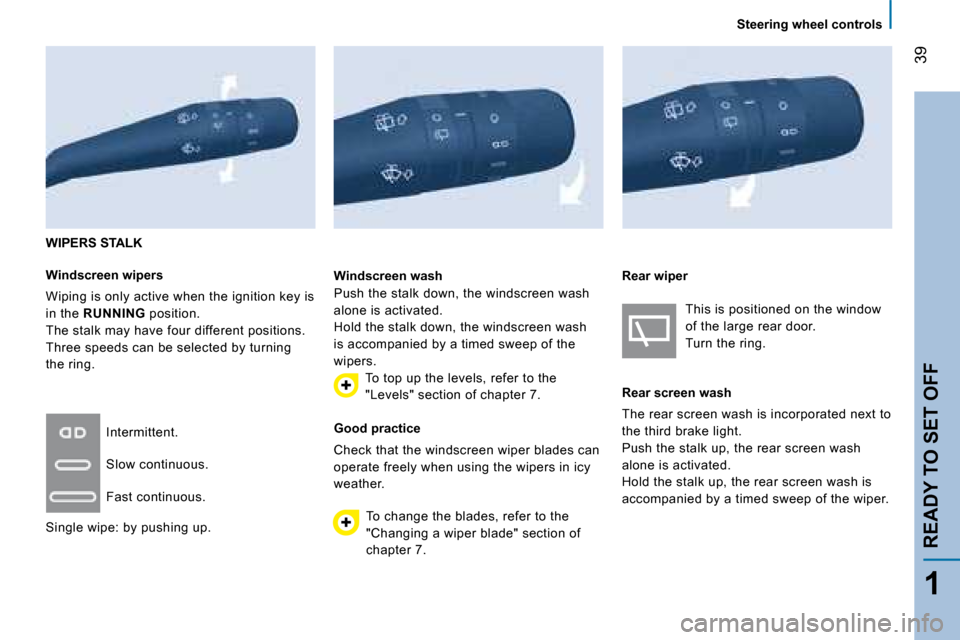
39
1
READY TO SET OFF
Steering wheel controls
WIPERS STALK
Windscreen wipers
Wiping is only active when the ignition key is
in the RUNNING position.
The stalk may have four different positions.
Three speeds can be selected by turning
the ring.
To change the blades, refer to the
"Changing a wiper blade" section of
chapter 7.
Good practice
Check that the windscreen wiper blades can
operate freely when using the wipers in icy
weather.
Intermittent.
Slow continuous.
Fast continuous.
Single wipe: by pushing up.
Windscreen wash
Push the stalk down, the windscreen wash
alone is activated.
Hold the stalk down, the windscreen wash
is accompanied by a timed sweep of the
wipers. To top up the levels, refer to the
"Levels" section of chapter 7. This is positioned on the window
of the large rear door.
Turn the ring.
Rear screen wash
The rear screen wash is incorporated next to
the third brake light.
Push the stalk up, the rear screen wash
alone is activated.
Hold the stalk up, the rear screen wash is
accompanied by a timed sweep of the wiper.
Rear wiper
Page 51 of 140
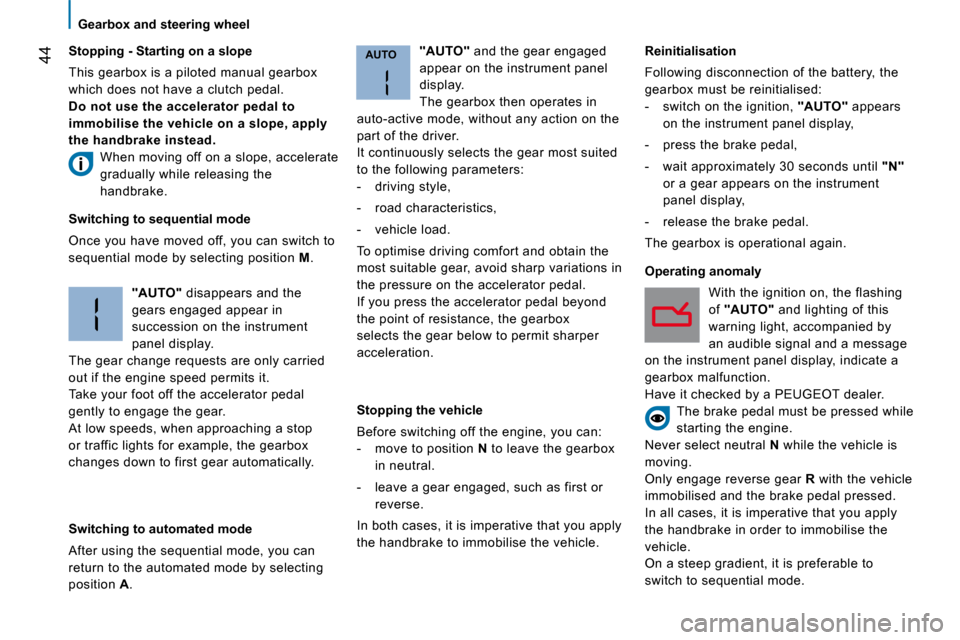
AUTO44
Gearbox and steering wheel
Stopping - Starting on a slope
This gearbox is a piloted manual gearbox
which does not have a clutch pedal.
Do not use the accelerator pedal to
immobilise the vehicle on a slope, apply
the handbrake instead.
When moving off on a slope, accelerate
gradually while releasing the
handbrake.
Switching to sequential mode
Once you have moved off, you can switch to
sequential mode by selecting position M .
"AUTO" disappears and the
gears engaged appear in
succession on the instrument
panel display.
The gear change requests are only carried
out if the engine speed permits it.
Take your foot off the accelerator pedal
gently to engage the gear.
At low speeds, when approaching a stop
or traffic lights for example, the gearbox
changes down to first gear automatically.
Switching to automated mode
After using the sequential mode, you can
return to the automated mode by selecting
position A .
"AUTO" and the gear engaged
appear on the instrument panel
display.
The gearbox then operates in
auto-active mode, without any action on the
part of the driver.
It continuously selects the gear most suited
to the following parameters:
- driving style,
- road characteristics,
- vehicle load.
To optimise driving comfort and obtain the
most suitable gear, avoid sharp variations in
the pressure on the accelerator pedal.
If you press the accelerator pedal beyond
the point of resistance, the gearbox
selects the gear below to permit sharper
acceleration.
Stopping the vehicle
Before switching off the engine, you can:
- move to position N to leave the gearbox
in neutral.
- leave a gear engaged, such as first or reverse.
In both cases, it is imperative that you apply
the handbrake to immobilise the vehicle.
Reinitialisation
Following disconnection of the battery, the
gearbox must be reinitialised:
- switch on the ignition, "AUTO" appears
on the instrument panel display,
- press the brake pedal,
- wait approximately 30 seconds until "N"
or a gear appears on the instrument
panel display,
- release the brake pedal.
The gearbox is operational again.
Operating anomaly
With the ignition on, the flashing
of "AUTO" and lighting of this
warning light, accompanied by
an audible signal and a message
on the instrument panel display, indicate a
gearbox malfunction.
Have it checked by a PEUGEOT dealer. The brake pedal must be pressed while
starting the engine.
Never select neutral N while the vehicle is
moving.
Only engage reverse gear R with the vehicle
immobilised and the brake pedal pressed.
In all cases, it is imperative that you apply
the handbrake in order to immobilise the
vehicle.
On a steep gradient, it is preferable to
switch to sequential mode.
Page 92 of 140
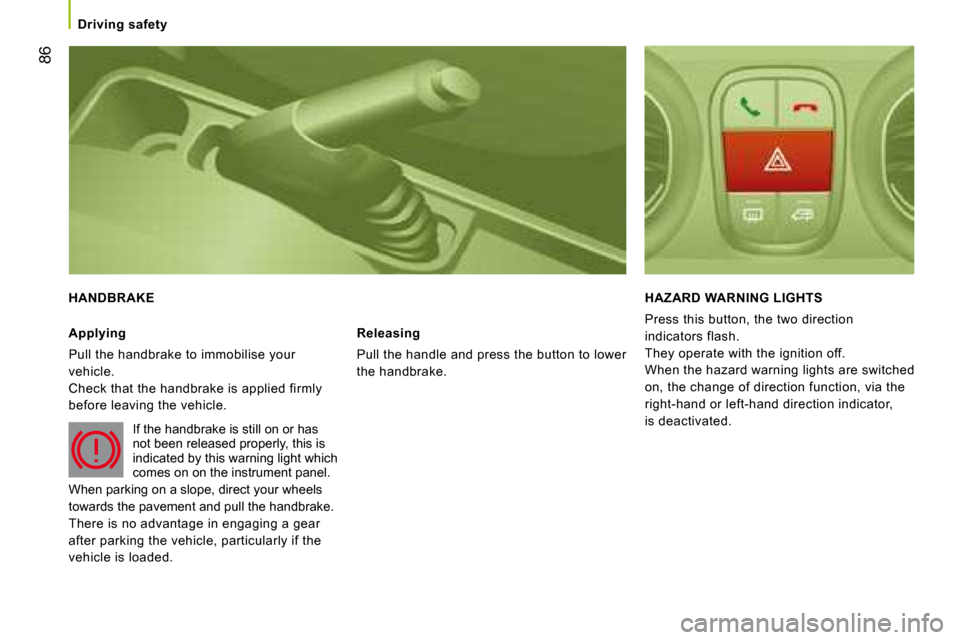
86
Driving safety
HANDBRAKE
Applying
Pull the handbrake to immobilise your
vehicle.
Check that the handbrake is applied firmly
before leaving the vehicle. If the handbrake is still on or has
not been released properly, this is
indicated by this warning light which
comes on on the instrument panel.
When parking on a slope, direct your wheels
towards the pavement and pull the handbrake.
There is no advantage in engaging a gear
after parking the vehicle, particularly if the
vehicle is loaded.
Releasing
Pull the handle and press the button to lower
the handbrake.
HAZARD WARNING LIGHTS
Press this button, the two direction
indicators flash.
They operate with the ignition off.
When the hazard warning lights are switched
on, the change of direction function, via the
right-hand or left-hand direction indicator,
is deactivated.
Page 93 of 140
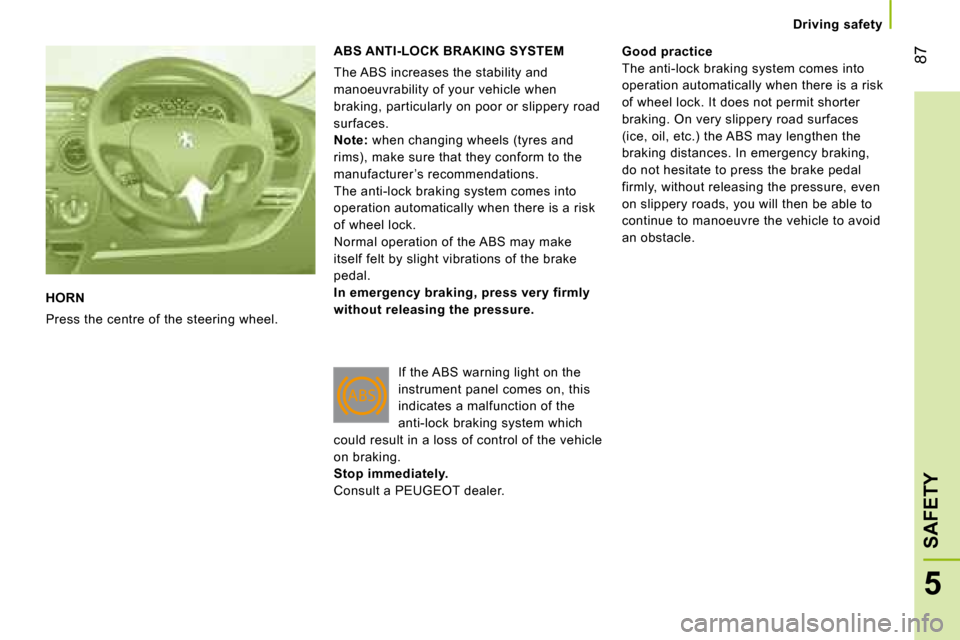
87
5
SAFETY
Driving safety
HORN
Press the centre of the steering wheel.
ABS ANTI-LOCK BRAKING SYSTEM
The ABS increases the stability and
manoeuvrability of your vehicle when
braking, particularly on poor or slippery road
surfaces.
Note: when changing wheels (tyres and
rims), make sure that they conform to the
manufacturer ’s recommendations.
The anti-lock braking system comes into
operation automatically when there is a risk
of wheel lock.
Normal operation of the ABS may make
itself felt by slight vibrations of the brake
pedal.
In emergency braking, press very firmly
without releasing the pressure.
If the ABS warning light on the
instrument panel comes on, this
indicates a malfunction of the
anti-lock braking system which
could result in a loss of control of the vehicle
on braking.
Stop immediately.
Consult a PEUGEOT dealer.
Good practice
The anti-lock braking system comes into
operation automatically when there is a risk
of wheel lock. It does not permit shorter
braking. On very slippery road surfaces
(ice, oil, etc.) the ABS may lengthen the
braking distances. In emergency braking,
do not hesitate to press the brake pedal
firmly, without releasing the pressure, even
on slippery roads, you will then be able to
continue to manoeuvre the vehicle to avoid
an obstacle.
Page 111 of 140

102
Towing a trailer
In certain cases of particularly arduous
use (towing the maximum load up a steep
slope in high temperatures), the engine
automatically limits its power. In this
case, the automatic cutting off of the air
conditioning allows the engine power to be
recovered.
If the coolant temperature
warning light comes on, stop the
vehicle and switch off the engine
as soon as possible.
See the "Levels" section of chapter 7.
Tyres: check the tyre pressures of the
towing vehicle (see the "Identification
features" section of chapter 7) and of
the trailer, observing the recommended
pressure.
Brakes: towing increases the braking
distance. Drive at a moderate speed,
change down early and brake gradually.
Side wind: sensitivity to side wind is
increased. Drive smoothly and at a
moderate speed.
ABS: the system only controls the vehicle,
not the trailer.
Rear parking assistance: the
assistance will be deactivated
automatically when an original PEUGEOT
towbar is used (see the "Rear parking
assistance" section of chapter 4).
Towbar
We recommend the use of original
PEUGEOT towbars and their harnesses,
which have been tested and approved from
the design stage of your vehicle, and that
the fitting of this equipment is entrusted to a
PEUGEOT dealer .
If this equipment is not fitted by a PEUGEOT
dealer , it is essential that it is fitted using
the electrical pre-equipment located at the
rear of the vehicle in accordance with the
manufacturer ’s instructions.
The operation of the sensors is deactivated
automatically when the pin of the trailer
cable is inserted in the towbar socket.
When the trailer cable pin is removed, the
sensors are re-activated.
Distribution of loads
Dis t r ibut e t he load in t he t r ailer s o t hat t he
heav ies t objec t s ar e as c los e as pos s ible
t o t he ax le and t he nos e weight is c los e
t o t he max imum aut hor is ed wit hout ,
howev er, ex c eeding it . T he air dens it y
dec r eas es wit h alt it ude, s o r educ ing t he
per f or manc e of t he engine. T he max imum
t owed load mus t be r educ ed by 10 % f or
eac h 1 000 met r es of alt it ude. Ref er t o
t he " Tec hnic al dat a" c hapt er f or det ails of
t he weight s and t owed loads applic able t o
y our v ehic le and als o t o t he adminis t r at iv e
doc ument s ( V5 r egis t r at ion doc ument , . . . ) .